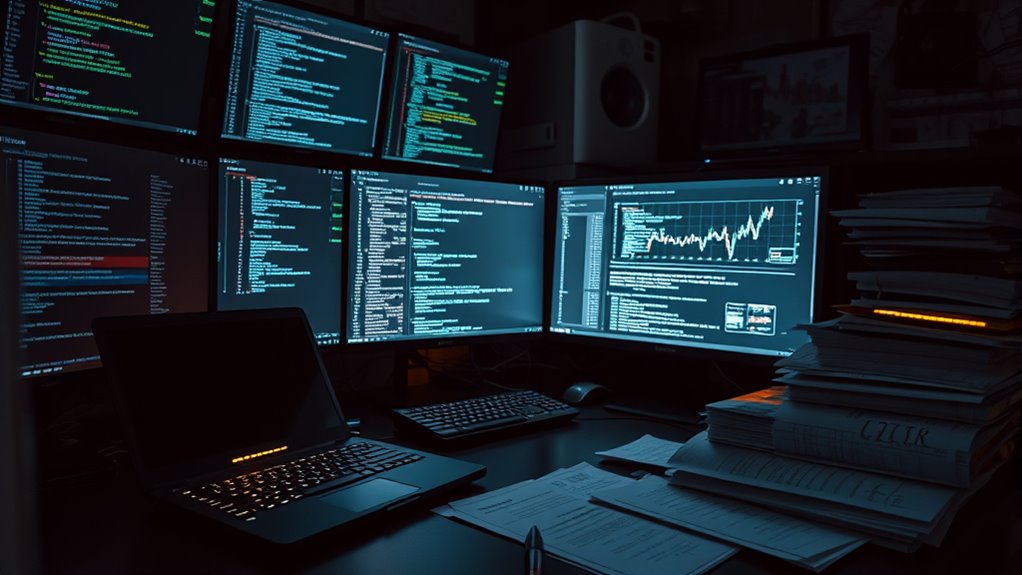Zero-day markets operate as hidden economies where software flaws are bought and sold for millions, driven by high demand from nation-states, cybercriminals, and organizations. Sellers profit from exploiting the scarcity and strategic value of these vulnerabilities, often through secretive channels with encryption and escrow services. The market’s opacity and legal ambiguities enhance profits but also elevate risks. To fully grasp how these underground deals influence cybersecurity, pay attention to key players, trends, and safeguards behind the scenes.
Key Takeaways
- Zero-day exploits are highly valuable commodities sold in covert markets driven by demand from nation-states, cybercriminals, and strategic actors.
- Pricing depends on vulnerability severity, target prevalence, exploit reliability, novelty, and evasion capabilities, often reaching millions of dollars.
- Transactions occur in encrypted, secretive environments using auctions, escrow, and cryptographic tools to protect anonymity and reduce legal risks.
- Sellers are motivated by profit, with high payouts incentivizing the discovery and sale of critical, unpatched vulnerabilities.
- Market opacity and legal uncertainties increase risks, influencing supply, demand, and pricing dynamics within the underground zero-day economy.
Understanding Zero-Day Vulnerabilities and Exploits

Understanding zero-day vulnerabilities and exploits is essential because these hidden security flaws can be exploited by attackers before vendors even become aware of them. Zero-day vulnerabilities are flaws in software or hardware that haven’t been discovered or patched yet. They exist until someone finds and reports them, which could be cybersecurity researchers, hackers, or even vendors. Exploiting these flaws allows threat actors to plant malware, steal sensitive data, or cause system damage without detection. Zero-day exploits are highly dangerous because they operate before any fix is available. These exploits often require sophisticated techniques, making them more effective and harder to defend against. Additionally, the existence of unpatched vulnerabilities increases the risk of widespread exploitation. As a result, zero-day vulnerabilities pose a significant security risk, emphasizing the importance of rapid detection and response.
The Structure and Mechanics of Zero-Day Markets

You’ll see that zero-day markets revolve around key participants like brokers and buyers who manage transactions and inventories. Pricing depends on factors like time sensitivity, rarity, and patch availability, making valuations complex. Transactions often occur through covert methods, with risks amplified by market opacity and legal uncertainties. The demand for high-performance projectors illustrates how technological factors can influence valuation and market dynamics within specialized sectors.
Market Participants and Roles
Zero-day markets consist of a diverse array of participants, each playing a critical role in the complex and secretive ecosystem. Suppliers, usually security researchers, discover and develop exploits for sale. Brokers act as market makers, managing inventories and connecting suppliers with buyers while maintaining anonymity. Buyers, often government agencies or organizations, seek to exploit vulnerabilities for offensive operations. Intermediaries facilitate secure, encrypted channels linking suppliers and buyers. Vendors may sell exploits directly or through intermediaries. The relationships are hierarchical, with administrators overseeing transactions and technical experts handling exploit development. Transactions occur in highly vetted, encrypted environments using double-blind auctions and cryptographic tools to preserve secrecy. This structure enables a clandestine marketplace driven by profit, with limited transparency and significant security risks. Security research plays a vital role in identifying and responsibly disclosing vulnerabilities to reduce potential harm.
Pricing and Valuation Factors
Pricing in zero-day markets hinges on a range of factors that directly influence an exploit’s value. Target prevalence matters—exploits aimed at widely used platforms like Windows command higher prices because they affect more users. Exploit reliability also boosts value; fully reliable exploits that work consistently are more desirable. Ease of use impacts pricing—zero-click exploits fetch premium prices over those requiring user interaction. Vulnerability class plays a role; remote code execution (RCE) and access violations command higher prices, while less critical issues like DoS or spoofing fetch less. Exclusivity and novelty are key—no public patches maximize value. Market segmentation influences prices too, with black markets offering the highest due to secrecy and risk. Ultimately, exploit complexity, development effort, stealth, and payload control further determine worth. Additionally, the level of stealth and the ability to evade detection significantly enhance an exploit’s market price.
Transaction Methods and Risks
Transaction methods in zero-day markets are varied and often involve complex arrangements designed to maintain secrecy and mitigate risk. You might encounter direct sales, where exploits are negotiated privately between researchers or brokers and buyers like governments or cybercriminal groups. Alternatively, brokers and marketplaces facilitate transactions, sometimes using auction models to push prices higher among interested bidders. Trusted escrow services are common to secure payments and ensure exploit delivery, reducing risks for both parties. Strict NDAs and confidentiality agreements protect identities and details of the exploits. Additionally, some market participants use secure communication channels to further safeguard their operations and maintain anonymity. However, risks remain: legal grey areas threaten prosecution, and counterparty risks include scams or non-functional exploits. Both buyers and sellers face exposure to law enforcement and potential reputational harm, especially if exploits are leaked or duplicated, undermining market trust and value. Due to the high volatility and secrecy involved, market participants often rely on specialized security protocols to safeguard their operations and identities.
Economic Motivations Behind Zero-Day Trades

Financial incentives are the primary driver motivating sellers to participate in zero-day markets. You’ll find that most sellers chase profit, as high payouts in black markets often surpass those from bug bounty programs. Criminal demand and increased risks push prices even higher. For many, ethical concerns are secondary; they sell to the highest bidder regardless of how the exploit will be used. Regulatory gaps and limited oversight reduce legal risks, making the trade more attractive. When nation-states buy exploits, prices skyrocket because of their strategic importance. The market remains opaque, with buyers holding more information than sellers, which skews pricing. The clandestine nature of the market ultimately, the promise of substantial financial gain, especially from powerful buyers, fuels participation in these secretive, high-stakes transactions. Additionally, the lack of transparency and oversight in cybercrime markets contributes to the ongoing profitability for sellers and the high valuation of these exploits.
Notable Case Studies and Their Global Impact

Notable zero-day cases have revealed how these vulnerabilities can cause widespread disruption and reshape global cybersecurity landscapes. For instance, Yahoo’s 2013 attack exposed over 3 billion accounts, impacting its acquisition by Verizon. Alibaba’s 2019 data scraping affected 1.1 billion users, while LinkedIn’s 2021 breach scraped 90% of user data through API exploitation. Facebook’s 2019 breach exposed data of over 530 users, and Marriott’s 2018 vulnerabilities led to significant cyberattacks. These incidents demonstrate how zero-days can be exploited for geopolitical gains, as seen with Stuxnet targeting Iran’s nuclear facilities, or for financial damage, like the Kaseya ransomware attack. Such cases highlight the profound global impact of zero-day vulnerabilities, from data breaches to strategic cyberwarfare, emphasizing the importance of understanding these risks. Zero-day vulnerabilities can be sold on the black market for millions of dollars, further fueling their proliferation and malicious use worldwide. Additionally, the cybersecurity industry continually evolves to develop better detection and mitigation strategies against these threats.
Strategies for Defense and Risk Mitigation

To defend against zero-day threats effectively, you need to focus on rapid patch deployment and proactive vulnerability testing to close security gaps quickly. Educating your users about potential risks helps prevent social engineering and accidental breaches. Regularly updating systems reduces the window of opportunity for attackers. Implementing attack surface management practices can further limit vulnerabilities and improve your overall security posture. By combining these strategies, you can reduce your attack surface and respond swiftly to emerging exploits.
Rapid Patch Deployment
Rapid patch deployment is essential for minimizing the window of vulnerability after a zero-day exploit is discovered. You should maintain a thorough inventory of all hardware, software, and endpoints, updating it continuously with automated tools. Prioritize patches based on asset criticality, linking vulnerability data to focus on the most exposed systems. Classify patches by severity, addressing critical vulnerabilities first, and develop clear schedules that separate urgent updates from routine ones. Leverage AI-driven solutions and platforms like SCCM or BigFix to automate detection, testing, and deployment. Use phased rollouts to minimize disruptions and monitor system behavior throughout. Regularly review deployment success, track patch effectiveness, and adapt strategies based on real-time data. This approach ensures faster response times and reduces your organization’s risk exposure effectively. Effective patch management also relies on continuous monitoring and adaptive strategies to stay ahead of emerging threats.
Proactive Vulnerability Testing
Proactive vulnerability testing is a critical component of an effective cybersecurity strategy, as it allows you to identify and address weaknesses before attackers can exploit them. You can use statistical and rule-based methods to prioritize vulnerabilities based on exploit likelihood, considering factors like exploit availability and CVSS scores. Integrating frameworks like MITRE ATT&CK helps map vulnerabilities to attacker tactics for targeted assessments. Active testing, such as port scanning and fuzzing, aggressively uncovers security flaws but may disrupt operations, while passive testing analyzes traffic and configurations safely, though it might miss some issues. Combining both approaches enhances detection without excessive impact. Regular metrics, like Time to Remediate and Fix Rate, guide continuous improvements, and fostering a security-first culture ensures early vulnerability detection and swift response. Dynamic communication exercises can also be incorporated into team training to improve response coordination and awareness during security incidents.
User Awareness Training
Effective user awareness training is a vital defense layer that greatly reduces the risk of cybersecurity incidents. When you invest in tailored, interactive programs, you can lower phishing click rates by 30% and diminish breach chances by 65%. Regular sessions, ideally quarterly, reinforce good habits and enhance security. Industry-specific scenarios and role-based content make training more relevant and impactful. Employees who receive ongoing development tend to stay longer—up to 94%. Additionally, 97.6% of organizations with effective training avoid public data breaches. While measuring behavioral change remains challenging, incorporating incentives and recognition boosts engagement. Remember, training focused on behavior rather than compliance produces better results, and continuous, targeted education is your best strategy to mitigate risks and defend against evolving threats.
Trends Shaping the Future of Zero-Day Commerce

As zero-day markets continue evolving, new trends are shaping how exploits are developed, traded, and used. You’ll see a growing focus on targeting enterprise platforms, with 44% of exploits in 2024 aimed at security and networking vulnerabilities, up from 37% in 2023. Meanwhile, exploits for browsers and mobile OS are decreasing, thanks to better security practices. Sophistication in malware is rising, especially with AI-enhanced techniques like memory-only operations and anti-VM measures to evade detection. Zero-day threats are increasingly impacting critical infrastructure—energy, water, and transportation—often lying dormant before activation. The market demand remains strong, driven by nation-states and cybercriminals, with record disclosures expected in 2025. These trends highlight a shifting landscape emphasizing advanced, targeted, and covert exploitation methods. The rise of advanced polymorphic techniques underscores the increasing complexity and evasiveness of modern zero-day malware.
Ethical and Legal Dilemmas in Vulnerability Disclosure

Vulnerability disclosure presents a complex ethical and legal landscape, requiring you to carefully weigh the potential risks and benefits of sharing sensitive information. Legally, you must consider local laws to avoid criminal liability; public disclosure without consent can violate statutes like the U.S. CFAA. Ethical concerns center on timing and method—responsible disclosure aims to protect users by allowing vendors time to develop patches, while immediate disclosure risks exposing systems before fixes are available. Confidentiality is critical initially to prevent attackers from exploiting details, and communication must be secure and clear. You also face conflicts of interest among stakeholders—researchers, companies, governments—each with competing priorities. Poor disclosure can lead to exploitation, harm reputations, and erode trust, emphasizing the importance of balancing transparency with legal and ethical responsibilities. Understanding legal frameworks is essential to navigate potential liabilities and ensure responsible disclosure practices.
Challenges and Opportunities in Regulating Zero-Day Markets

Regulating zero-day markets presents a complex challenge because of their inherently secretive and decentralized nature. Transactions happen anonymously, making enforcement difficult and enabling illegal activities to thrive. Existing regulations have failed to keep pace, often limited by narrow definitions and legal loopholes. The trade has become highly sophisticated, involving not only software flaws but also operational knowledge, which increases risks. The global security threat is significant, as zero-day exploits can fall into malicious hands, fueling cyber warfare and espionage. The high demand, driven by financial incentives and geopolitical needs, amplifies market volatility. While voluntary measures and international cooperation offer opportunities, developing effective laws and advanced security tech remains critical. Without strong regulation, businesses and consumers continue to face mounting risks. Zero-day exploits are often discovered first by hackers or malicious actors, which makes early detection and intervention even more challenging.
Frequently Asked Questions
How Do Zero-Day Markets Influence Overall Cybersecurity Risk?
Zero-day markets substantially raise cybersecurity risks because they fuel the sale of vulnerabilities to the highest bidder. When you rely on software, these markets mean attackers can quickly find and exploit unseen flaws, making systems more vulnerable. The high value of zero-days encourages more attacks, increases the sophistication of threats, and complicates defenses. As a result, your organization faces greater chances of data breaches, disruptions, and long-term security challenges.
What Role Do State Actors Play in Zero-Day Trading?
Think of state actors as puppeteers pulling the strings in zero-day trading. They buy vulnerabilities to craft digital weapons, shaping market demand and prices while keeping secrets tight-lipped. By acting as both consumers and clandestine traders, they influence the flow of exploits and maintain a delicate balance between offense and defense. Their involvement fuels a shadowy arena, making cybersecurity a complex chess game with high stakes.
Can Legitimate Vendors Detect Embedded Zero-Day Exploits?
You can detect embedded zero-day exploits by using advanced security measures like network anomaly detection, behavioral analysis, and code testing. Continuous monitoring with machine learning helps identify unusual activities early. Combining static and dynamic code analysis along with penetration testing and bug bounty programs increases your chances of uncovering hidden vulnerabilities. Staying updated with threat intelligence and sharing information with industry peers also boosts your ability to find and address zero-days before they cause harm.
How Are Zero-Day Brokers Ensuring Exploit Effectiveness and Security?
You’re diving into a high-stakes game where zero-day brokers go to extraordinary lengths to guarantee exploits work perfectly and stay secure. They rigorously evaluate vulnerabilities, demanding over 90% success rates, lightning-fast execution, and stealthy operations that avoid crashes or user interactions. They build exclusive, secretive networks with researchers and buyers, constantly refining exploits through technical feedback. This relentless focus assures their exploits remain effective, reliable, and impossible for others to detect or replicate.
What Are Future Technological Trends Impacting Zero-Day Vulnerability Trading?
You’re asking about future tech trends shaping zero-day trading. As AI and automation evolve, expect faster discovery and deployment of exploits, making attacks more sophisticated. Enterprise-targeted vulnerabilities will grow, especially in network infrastructure. Quantum computing poses new risks, especially for cryptography. Plus, the market will likely privatize further, increasing exploit speed and secrecy. Staying ahead means monitoring AI advancements, quantum threats, and shifts in market dynamics to protect your systems effectively.
Conclusion
So, next time you leave your door unsecured, remember there’s a bustling black market keen to buy your keys. Zero-day markets turn software flaws into gold mines, fueling a digital wild west where ethics and law are just optional accessories. Maybe it’s time to patch up those vulnerabilities before hackers turn your data into their next payday. After all, in this game, the highest bidder always wins—and nobody’s really safe.









